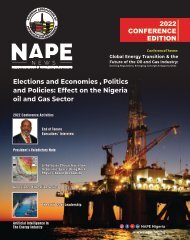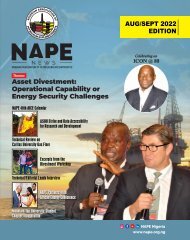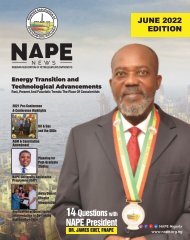NAPENews Magazine June 2023 Edition
NAPENews Magazine June 2023 Edition
NAPENews Magazine June 2023 Edition
Create successful ePaper yourself
Turn your PDF publications into a flip-book with our unique Google optimized e-Paper software.
BEYOND ROCKS AND MINERALS:<br />
HOW GEOSCIENCE GRADUATES CAN EXPLORE<br />
EXCITING CAREER PATHS IN DIGITAL TECHNOLOGY<br />
Geoscience is a field that has been<br />
around for centuries, but with the rise<br />
of digital technology, new career<br />
opportunities are emerging rapidly,<br />
a n d t h e d e m a n d f o r s k i l l e d<br />
professionals in this field is likely to<br />
continue to grow in the coming years.<br />
Powerful tools that were once<br />
accessible to only a few are now<br />
within the grasp of everyday users. In<br />
this article, we will see how<br />
geoscience graduates can take<br />
advantage of this new development<br />
that allows them to combine their<br />
passion for geoscience with cuttingedge<br />
technology.<br />
Technology is actively changing the<br />
geoscience field in so many ways.<br />
One of the ways is by simplifying the<br />
data collection process in terms of<br />
quantity and quality. Additionally,<br />
advances in computing power and<br />
data storage have made it easier for<br />
geoscientists to analyze large and<br />
complex datasets allowing for better<br />
understanding and interpretation.<br />
Every day, new software and<br />
machine learning algorithms are built<br />
to visualize, identify and interpret<br />
patterns and relationships within<br />
spatial data. Geological data is now<br />
better communicated to a wider<br />
audience in an accessible manner all<br />
thanks to the use of interactive maps,<br />
3D models and virtual reality tools.<br />
The automation of several data<br />
processing and analysis routine<br />
tasks has made it easier for<br />
geoscientists to focus on more<br />
complex and challenging tasks<br />
hence saving time and increasing<br />
efficiency. Recent innovations in<br />
geosciences have also brought an<br />
unprecedented level of technological<br />
advancement in the form of new tools<br />
and techniques. For example,<br />
autonomous underwater vehicles<br />
and seafloor mapping technologies<br />
have allowed earth scientists to<br />
explore and map the deep ocean in<br />
astonishing detail.<br />
As technology continues to advance,<br />
it is likely that its intersection with<br />
geosciences will continue to grow,<br />
l e a d i n g t o n e w i n s i g h t s a n d<br />
discoveries in this field. Hence, it is<br />
imperative that young graduates<br />
carve a career path that fully utilizes<br />
the opportunities these new fields<br />
offer.<br />
However, before choosing a career<br />
path, it is important to determine your<br />
interests and strengths. You need to<br />
ask yourself, 'Do I have a knack for<br />
using data to identify patterns and<br />
make predictions?', 'Am I fascinated<br />
by machine learning algorithms?',<br />
'Am I passionate about designing and<br />
developing software solutions?'.<br />
These are all important questions to<br />
ask when exploring career options.<br />
Once you have identified your<br />
interests and strengths, it is important<br />
to research the industry to determine<br />
which areas are in demand. Look for<br />
job postings and read articles on<br />
industry trends to get a sense of<br />
where the industry is headed. These<br />
actions would help throw more light<br />
on the best industry niches to apply<br />
to, pursue a career in or upskill on.<br />
Dear young geoscientist, now that<br />
you have a good understanding of<br />
your interests, strengths and your<br />
industry niche preference, it's time to<br />
explore different career paths that<br />
intersect geoscience and technology.<br />
Such as being a Geospatial Analyst,<br />
S o f t w a r e D e v e l o p e r , D a t a<br />
Geoscientist, Geohazard Analyst,<br />
Environmental Data Scientist or<br />
Machine learning engineer.<br />
The steps below are a suggested<br />
guide on how to do this. First, gain a<br />
s t r o n g u n d e r s t a n d i n g o f t h e<br />
geoscience fundamentals. It is<br />
important to focus on developing a<br />
deep understanding of natural<br />
p r o c e s s e s a n d g e o l o g i c a l<br />
formations, as this knowledge will<br />
form the basis for your use of<br />
t e c h n o l o g y . T h e n , s e e k o u t<br />
opportunities to work on research<br />
projects or internships that allow you<br />
to gain hands-on experience in your<br />
areas of interest.<br />
The next step is to improve your<br />
knowledge of the tools needed for<br />
success in your career of choice.<br />
Languages such as Python, R, and<br />
SQL have become increasingly<br />
important in developing custom<br />
algorithms for visualizing and<br />
interpreting large datasets. You may<br />
consider further education. This<br />
could include a graduate degree in a<br />
related field, such as data science or<br />
software engineering. Alternatively,<br />
you could look into specialized<br />
courses and certifications that can<br />
help you build the necessary skills.<br />
NAPENEWS JUNE <strong>2023</strong> 57










